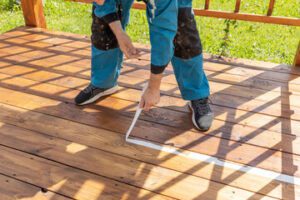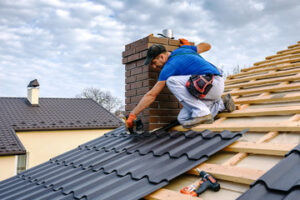Deck installation has evolved into a lifestyle choice. It is no longer just about adding square footage. The focus now is on connection, creativity, and customization. People want function to meet beauty outdoors.

Today’s deck designs blur the line between indoor and out. Installations include lighting, sound, and shade systems. These aren’t just spaces to sit anymore. They are made for dining, lounging, and living. Contact Deck Builders Murfreesboro TN for professional help.
Many homeowners now start with a mood board. They envision how morning coffee or evening wine feels. Decks become sanctuaries for everyday rituals. Emotion drives material and layout decisions.
Minimalism dominates current deck styles. Sleek lines and hidden hardware shape the look. Less clutter creates a peaceful environment. The trend leans toward calming visual harmony.
Materials today serve both purpose and aesthetic. Composite blends offer longevity and color consistency. Natural grains remain popular for warmth and charm. Some even mix materials for contrast.
Deck shapes no longer follow rigid lines. Curved borders soften space transitions. Multi-level layouts introduce dynamic flow. Each contour adds a sense of invitation.
Customization is key in modern deck installation. Built-in benches maximize seating and free up space. Some even incorporate raised garden beds. The deck becomes an active part of daily life.
Installers are increasingly working with difficult terrain. Slopes and uneven land require creative footings. Technology helps map soil density and drainage. Decks adapt rather than flatten the land.
Decks now factor in privacy from the start. Vertical slats, screens, and greenery offer seclusion. This creates intimate zones for rest. Design responds to human comfort needs.
Lighting transforms a deck’s nighttime personality. Recessed LEDs mark steps and borders. Soft string lights set a cozy mood. Power access becomes a hidden design priority.
Water-resistant features are now standard. Drainage systems prevent pooling and warping. Installers plan slope and spacing for longevity. Moisture control begins at the foundation.
Deck size depends on usage patterns. A couple might prefer a small coffee nook. A family may want zones for eating and play. Function dictates scale more than aesthetics.
The installation timeline is often underestimated. Weather, permits, and supply delays affect progress. Installers now pad schedules with extra days. Patience ensures quality over speed.
DIY kits appeal to budget-conscious buyers. Still, many underestimate the precision needed. Improper leveling or spacing causes long-term issues. Professional guidance is worth the cost.
The integration of eco-friendly choices is rising. Reclaimed wood and recycled composites lead the shift. Low-impact installation methods gain popularity. Green living starts with thoughtful construction.
Homeowners now ask about fire safety features. Materials must meet local burn resistance codes. Decks in high-risk zones need extra precautions. Safety now blends with design.
Decks are becoming multi-seasonal with heating. Infrared panels and fire tables extend usability. Covers and curtains block wind and rain. Installation now anticipates year-round comfort.
Storage is often built into deck design. Hidden compartments hold cushions, tools, or toys. Maximizing utility keeps spaces tidy. Every square inch gains purpose.
Sound systems are installed below deck boards. Speakers connect to indoor hubs or mobile apps. Music becomes part of the outdoor ambiance. Acoustics are shaped by layout and material choice.
Insect control is a modern challenge. Some decks include citronella planters or screened areas. Materials that repel pests are gaining demand. Relaxation requires a bite-free environment.
Color selection affects both look and feel. Lighter tones reduce heat during summer months. Dark hues create drama and depth. Shades reflect personal identity.
Decks near pools must meet slip-resistant standards. Textured finishes reduce accidents. Installers adjust angles to redirect splashes. Safety merges with design once again.
The permitting process varies by location. Installers handle documentation and inspection prep. Missed permits lead to fines or rebuilds. Legal steps protect long-term investment.
Furnishing the deck happens after installation. Modular pieces offer flexibility for events. Some use outdoor rugs for zoning. Furniture choices tie into overall experience.
Smart tech is part of new deck builds. Motion sensors control lights and sprinklers. Voice assistants manage ambiance. Convenience is wired into the frame.
Structural supports matter more than surface appeal. Joist spacing, post depth, and bracket type impact lifespan. These elements remain hidden yet critical. Quality lies in the unseen foundation.
Ventilation is a hidden but essential factor. Trapped air accelerates mold or odor issues. Decks must breathe beneath their boards. Installers create flow channels underneath.
Local climate dictates material durability. Some regions demand UV resistance or freeze-proof framing. Installers advise based on long-term exposure. Regional insight shapes product selection.
Deck extensions require matching old with new. Materials fade over time, making blending tough. Some choose intentional contrast instead. Creative design turns difference into highlight.
Pre-installation preparation includes land clearing. Roots, rocks, and underground lines are marked. This stage is often skipped in DIY projects. Thorough groundwork sets the stage for success.
Color fade warranties affect buyer decisions. Many now choose products with long-term guarantees. Maintenance schedules tie into this expectation. Reliable aging is part of smart investment.
Drainage systems are sometimes hidden in steps. Channels carry runoff away from foot traffic. This prevents algae and surface staining. Function hides beneath beauty.
Deck rails now follow minimalist trends. Slim metal or glass options expand the view. This enhances a sense of openness. Safety remains but looks less intrusive.
Cultural preferences shape layout too. Some cultures gather in circles or low seating zones. Others prefer open space and movement. Personal background influences design.
Children and pets affect installation planning. Edges are smoothed, gates installed, and surfaces softened. Safety features blend into structure. Family living requires forethought.
Colors extend beyond the boards. Railings, steps, and furniture all play a role. Coordinated palettes create cohesion. Decks become styled environments.
Power outlets are now embedded in deck corners. This supports appliances, work-from-home needs, and chargers. Access without extension cords is a modern must. Installers future-proof for convenience.
Seasonal changes create shifting shadows. Decks respond with adjustable shading tools. Pergolas, umbrellas, and retractable covers help. Sunlight becomes a design element.
Weight distribution matters for hot tubs or grills. Decks must be reinforced at critical points. Early planning avoids structural strain. Installers collaborate with appliance vendors.
Handrails can be design statements. Some mix materials for contrast and mood. Grips must meet accessibility codes. Form follows function with creativity.
Sloped yards lead to tiered deck layouts. Platforms offer segmented zones and better views. This creates vertical interest and usage variety. Installation complexity rises accordingly.
Accessibility adds value to any deck. Ramps, wide steps, and sturdy rails welcome all. Universal design improves resale appeal. Inclusion starts with entry points.
Wildlife proximity affects material choice. Decks in wooded areas face burrowing or nesting. Some materials deter animals more effectively. Environment shapes technical choices.
Some decks use solar lighting for sustainability. Panels charge during the day and power lights by night. Installation accounts for exposure angles. Energy independence starts small.
Roof decks follow different rules than ground ones. Weight, wind load, and fire codes tighten. Installers work closely with engineers. High altitude demands higher standards.
Privacy zones use planters, walls, or screens. Zoning within the deck creates intimacy. Visual separation enhances experience. Boundaries feel calm, not confined.
The best decks feel effortless. Great installation hides its effort behind comfort. Every nail and board carries intention. Mastery lies in the invisible details.




